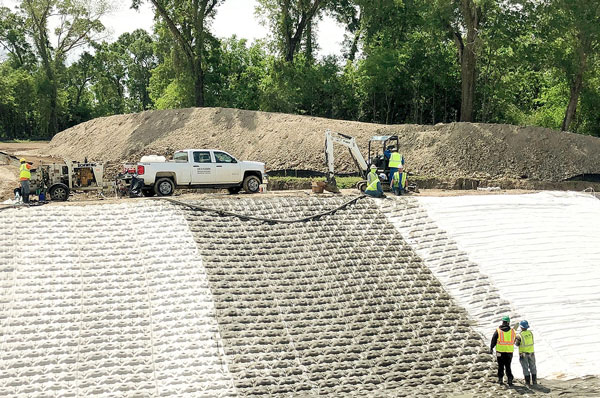Hydroseeding Solutions: A Greener Approach to Land Management
Wiki Article
Ideal Practices for Erosion Control in Building Projects
Are you dealing with a building and construction job and concerned regarding erosion control? Look no additional! In this post, we will assist you via the best methods for preventing erosion on your site. You'll find 5 important methods, reliable debris and overflow management techniques, crucial considerations for slope stablizing, and tips for securing vegetation and dirt. We'll likewise explore the relevance of applying correct drain systems. Prepare to deal with erosion head-on and ensure the success of your construction job.5 Important Erosion Control Strategies

To efficiently regulate disintegration on your building and construction site, you'll require to carry out crucial methods such as incline stabilization and sediment control procedures. Incline stablizing is crucial in avoiding soil erosion on steep inclines. An additional reliable method is the use of erosion control blankets or floor coverings, which are positioned on the incline and aid maintain dirt bits while allowing vegetation to expand.
Reliable Debris and Overflow Administration

You can successfully take care of sediment and overflow in your building and construction job by applying correct disintegration control procedures. Another crucial practice is the execution of disintegration control coverings or floor coverings. By carrying out these erosion control measures, you can effectively manage debris and runoff in your building and construction job, reducing the effect on the setting and abiding with regulative requirements.
Secret Considerations for Slope Stablizing
When considering slope stabilization, it is essential to analyze the surface and recognize prospective areas of instability. You need to carefully check out the incline's features, such as its make-up, drainage, and angle patterns. Search for indicators of disintegration, such as subjected roots, fractures, or slumping dirt. These indications can provide you an idea of where stablizing measures may be required.As soon as you have actually identified the unsteady locations, you can begin applying steps to stabilize the slope. One usual approach is the usage of keeping walls or terracing to develop a series of level steps, which can help distribute the weight and avoid further erosion. One more option is to grow plants on the slope, as the origins can assist anchor the dirt and control erosion. In addition, installing erosion control coverings or floor coverings can give instant security while vegetation becomes established.
It's crucial to frequently check the maintained slopes to ensure their efficiency. Maintain an eye out for any type of indications of motion or disintegration, and take instant activity if required. Normal upkeep, such as inspecting and fixing any type of broken procedures, is also vital to guarantee long-term stability.
Finest Practices for Plants and Dirt Security
If essential,One reliable method to safeguard plants and soil on useful reference inclines is by regularly checking for indications of erosion and taking instant action. By being proactive and watchful, you can prevent additional damage and make certain the stability of the incline. Begin by examining the slope for any kind of indicators of erosion, such as exposed roots, bare soil patches, or debris build-up near the bottom. If you see any of these indications, it is essential to resolve the issue promptly. Implement erosion control actions such as setting up erosion control blankets, mulching, and even creating retaining walls if needed. Additionally, planting greenery can dramatically help in supporting the soil. Select native plants that have deep root systems, as they are extra reliable in avoiding disintegration. Ensure to regularly evaluate the health and wellness of the plants and give necessary upkeep, like watering and feeding. Bear in mind, disintegration can swiftly aggravate and create severe damage, so it's important to address it as soon as feasible. By taking positive steps and frequently monitoring the incline, you can shield the plant life and soil, making sure the lasting their website stability of the area.Carrying Out Correct Drainage Systems
To efficiently execute appropriate drain systems, it's critical to take into consideration the incline gradient and dirt type. Understanding these elements is vital when it comes to taking care of water circulation and avoiding erosion. The slope gradient plays a substantial function in read what he said identifying just how water crosses the land. Steeper inclines can lead to much faster water circulation, raising the threat of erosion and flooding. On the various other hand, gentler slopes enable water to flow much more gradually, lowering disintegration possibility. By analyzing the incline gradient, you can develop an efficient drainage system that fits the natural water movement.Sandy soils often tend to drain pipes faster due to their rugged appearance, while clay soils have a slower water drainage rate due to their compact nature. In addition, thinking about the dirt features aids avoid waterlogging, which can lead to bad plant growth and damages to frameworks.
Verdict
In final thought, when it involves erosion control in building projects, you should adhere to these finest methods. Execute effective debris and overflow administration strategies to stop air pollution. Think about slope stablizing methods to make certain the stability of the site. Shield vegetation and dirt by utilizing suitable procedures. Last but not least, establish correct drainage systems to handle water flow. By following these essential practices, you can efficiently manage erosion and guarantee the success of your building and construction task.To effectively manage disintegration on your construction website, you'll need to implement important techniques such as slope stabilization and debris control steps. Incline stabilization is critical in avoiding dirt erosion on steep slopes. Another efficient method is the use of disintegration control coverings or mats, which are placed on the incline and assistance retain dirt bits while enabling vegetation to expand. One more option is to grow vegetation on the slope, as the origins can help secure the soil and control disintegration. Implement erosion control measures such as setting up disintegration control blankets, mulching, or also building preserving wall surfaces if required.
Report this wiki page